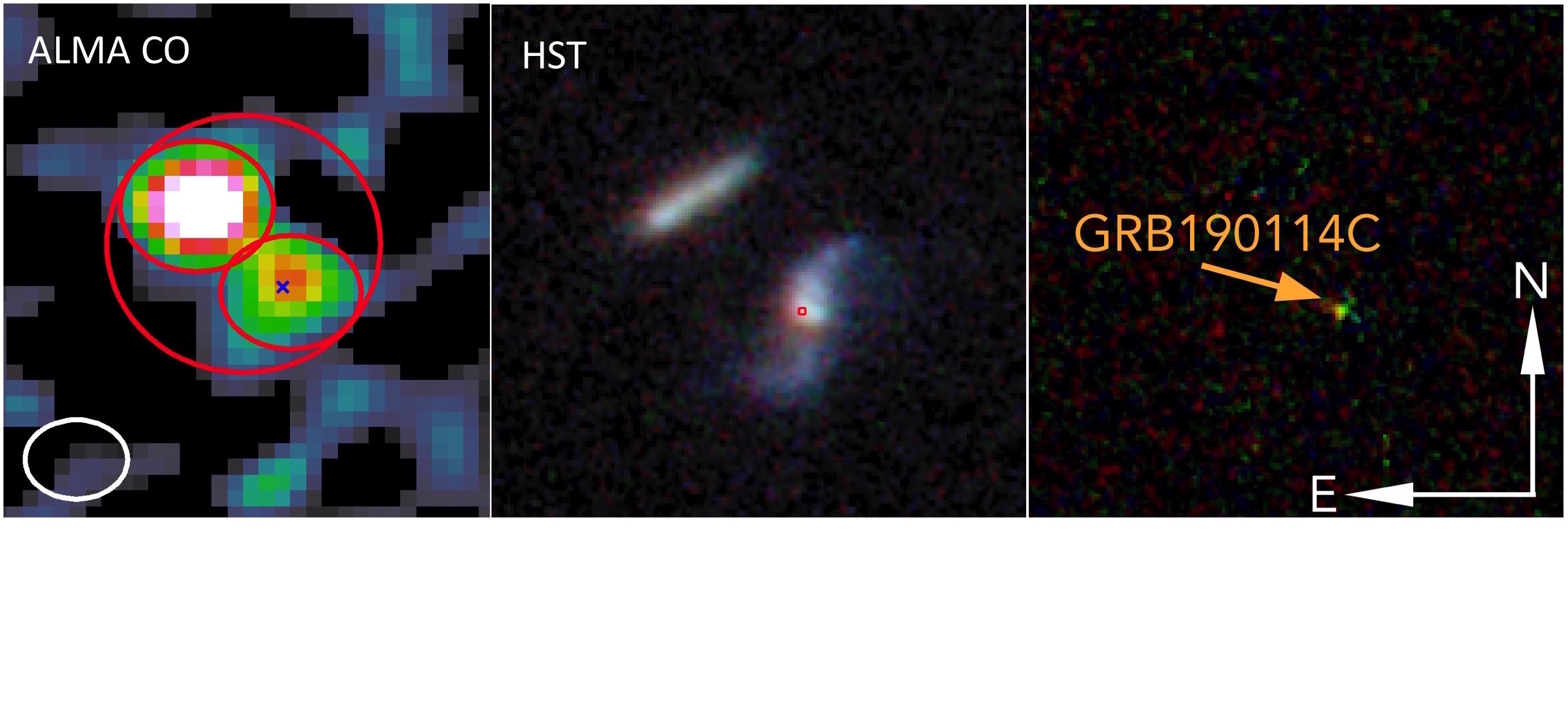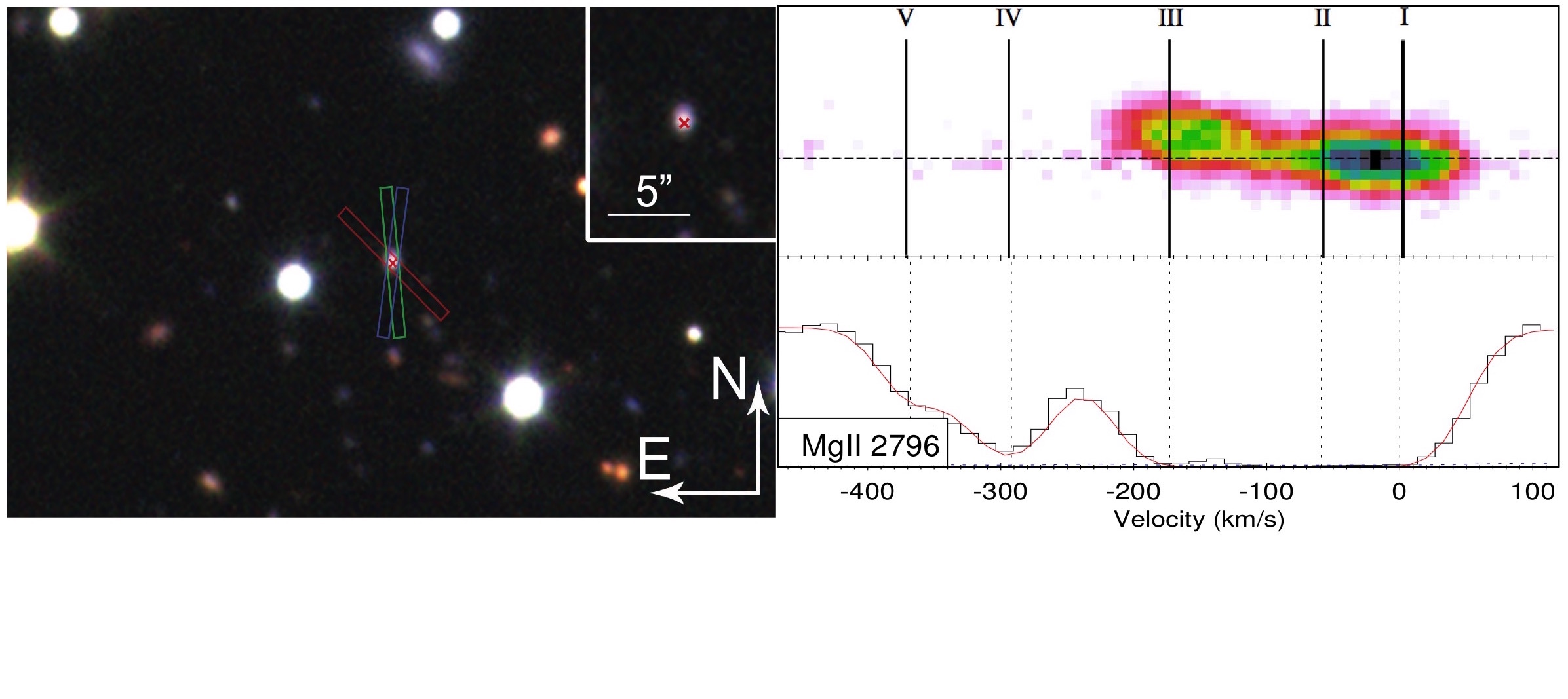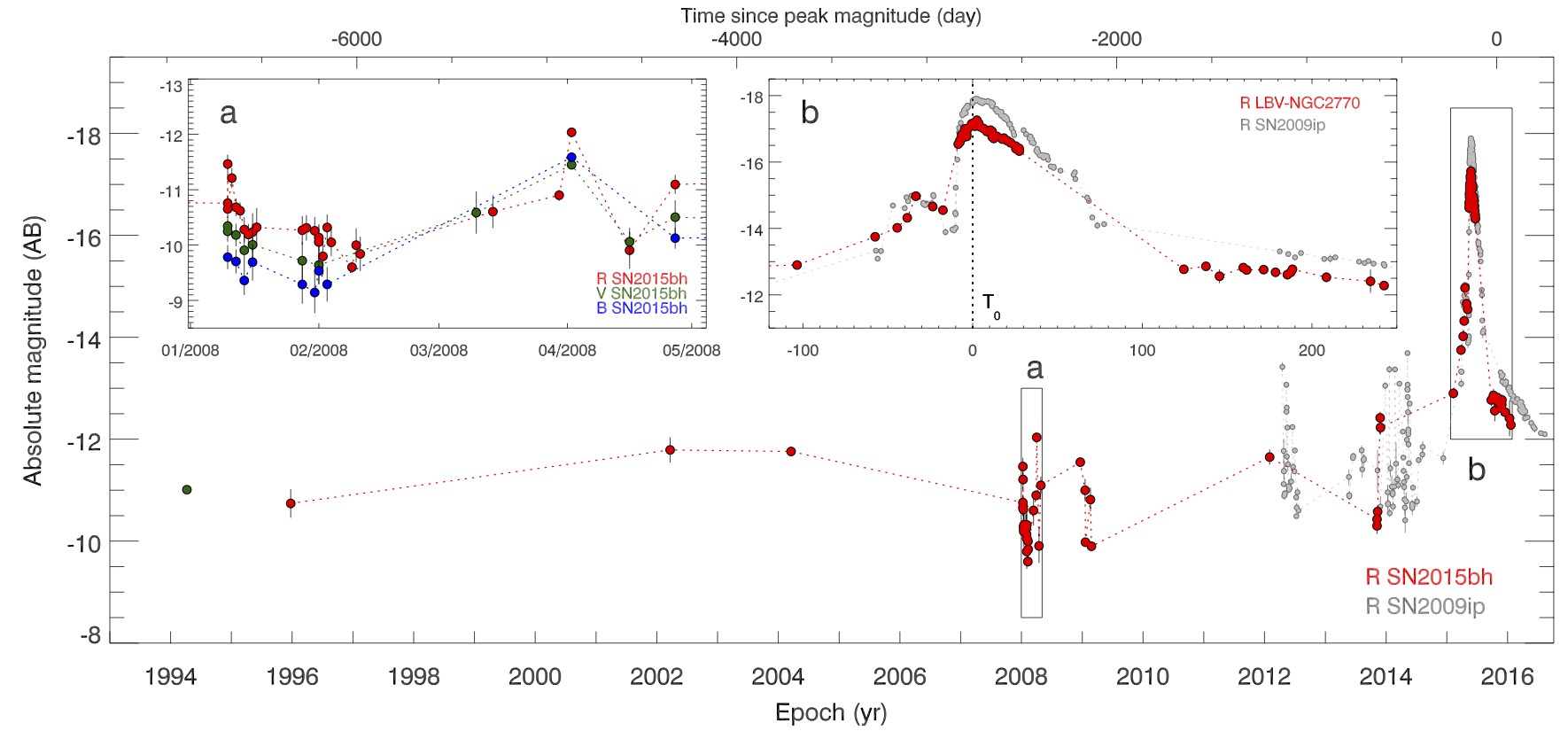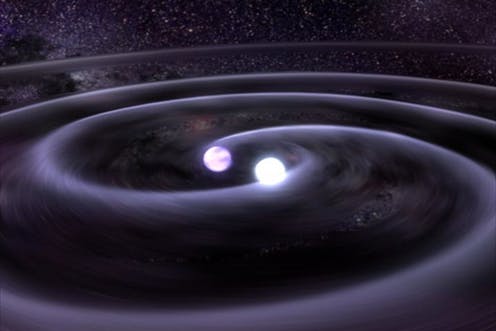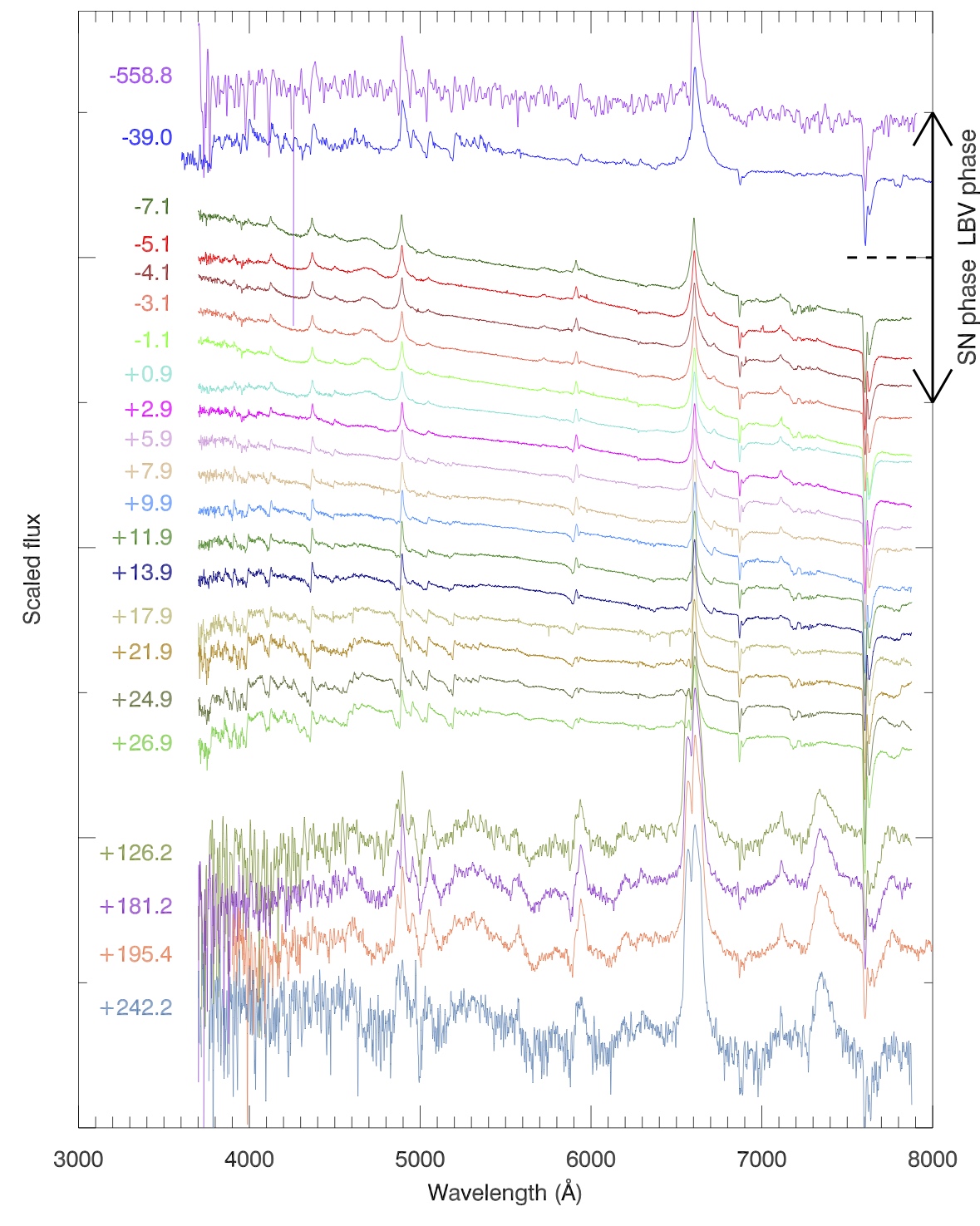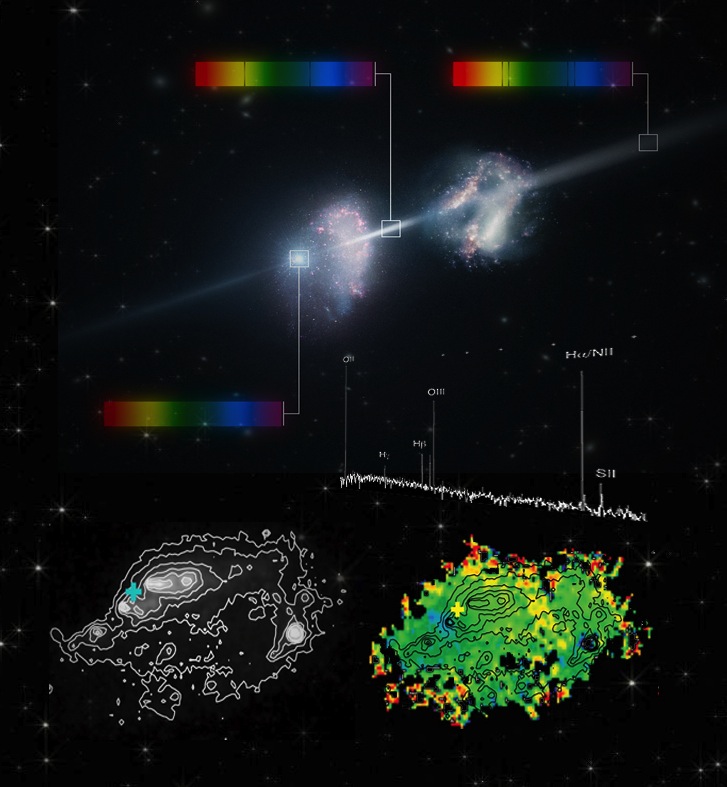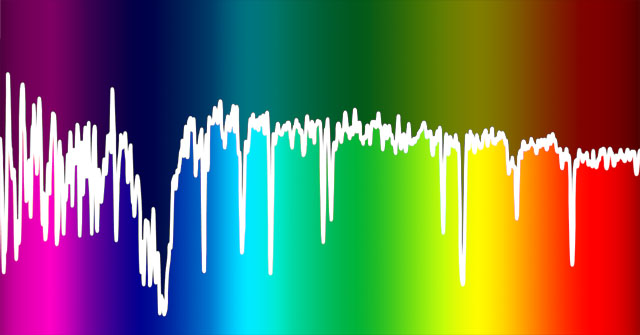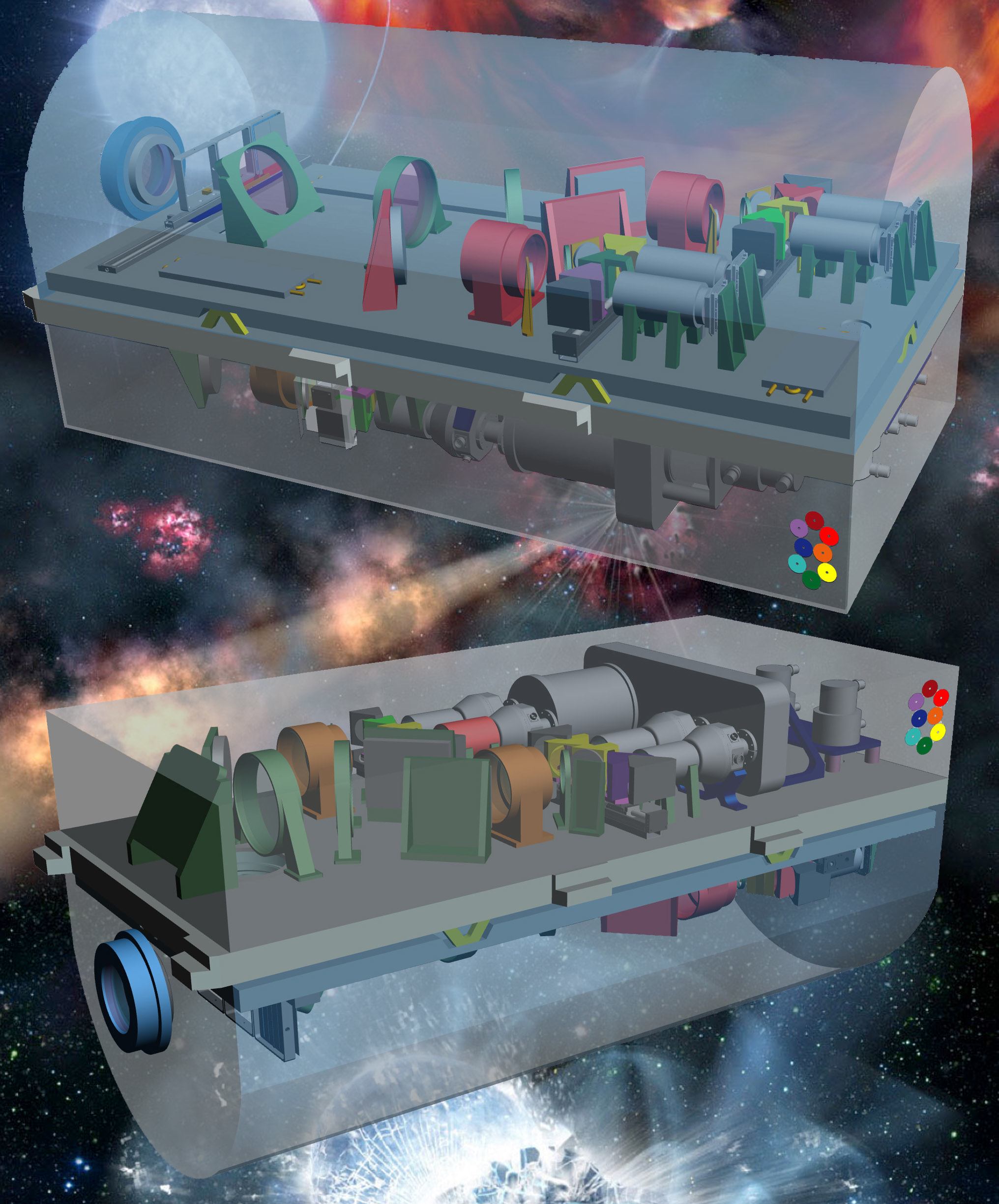The "MAGIC" GRB 190114C in the nuclear region of an interacting galaxy A study with ALMA, VLT and HST (de Ugarte Postigo et al. 2019)
HETH science
Our main interest is the study of (massive) stellar explosions, their environments and hosts.
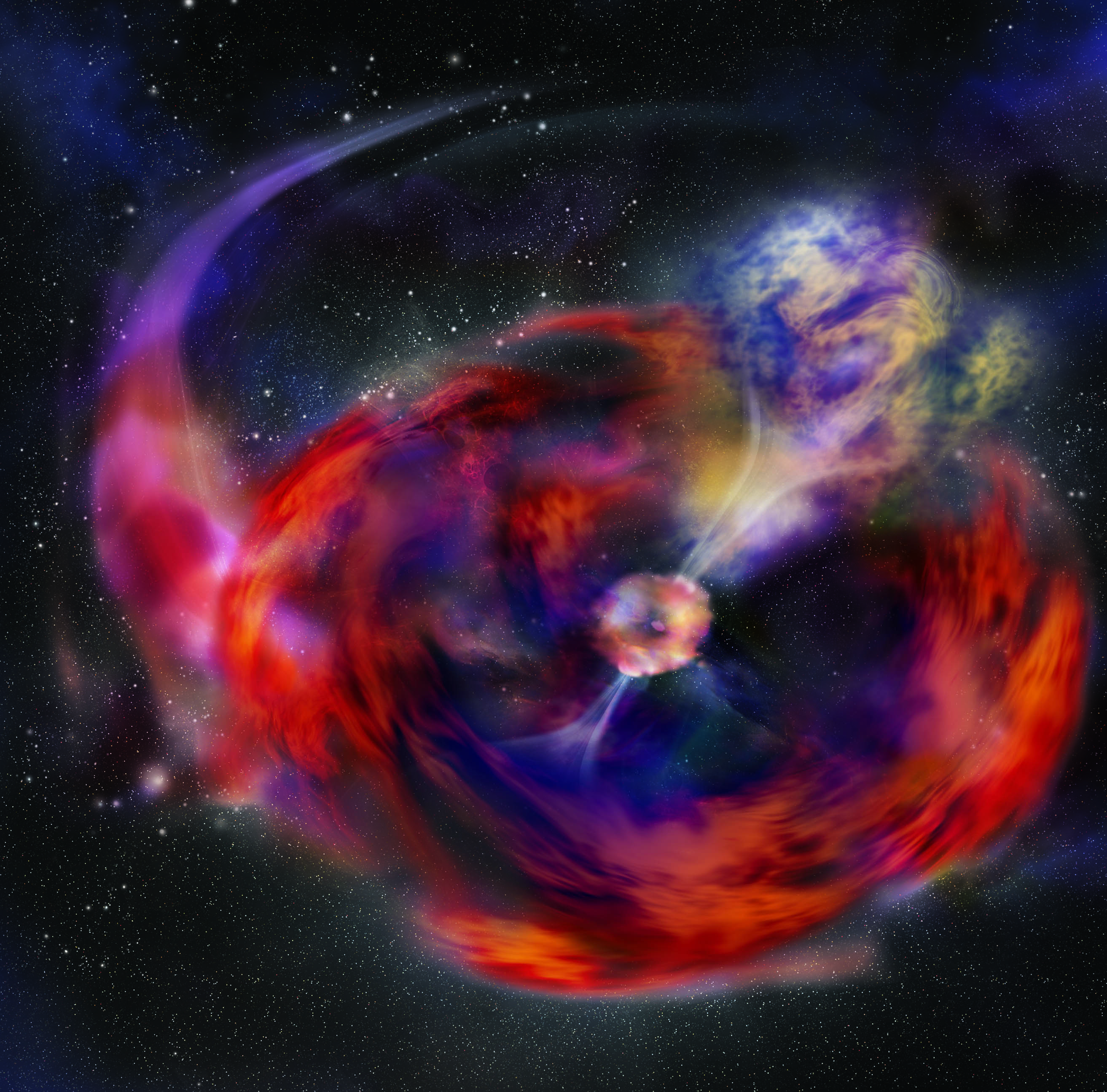
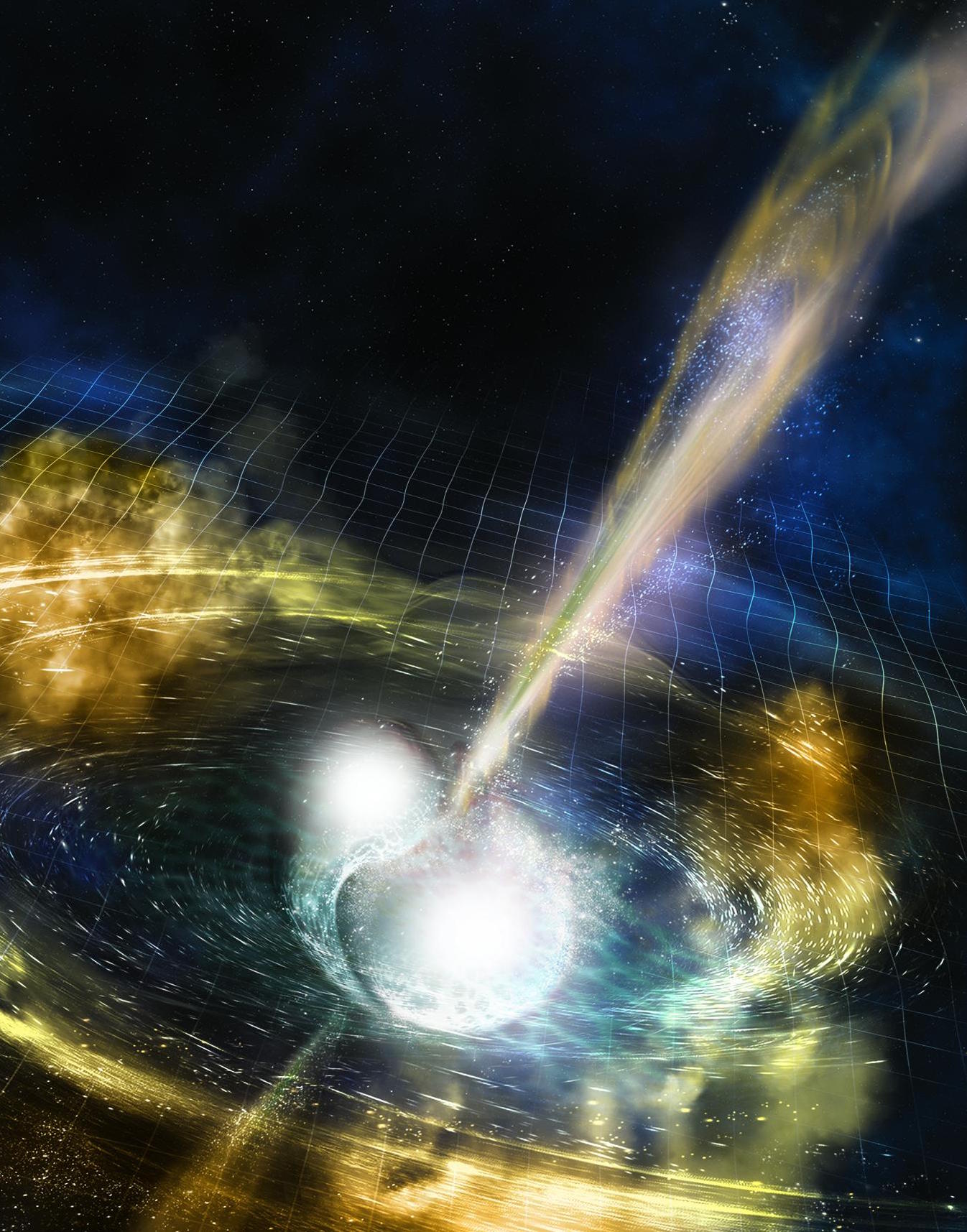
Gamma-ray burstsStrange GRBs and GRB-supernovae
Gamma-ray bursts are some of the most luminous explosions in the Universe. They are divided in long and short GRBs possibly reflecting two different progenitor types (death of a massive star vs. coalescence of two compact objects). Despite two decades of afterglow observations many mysteries still remain. HETH has designated ToO programs at different telescopes to follow GRB afterglows (e.g. GTC, OSN, ALMA and PdB). HETH people are also member of the European X-shooter collaboration on GRBs.
At HETH we study GRBs across all wavelengths from X-ray to radio. We focus on peculiar events such as the famous "Christmas Burst", GRB 101225A. The afterglow of this peculiar GRB showed mostly thermal emission in contrast to the usual power-law behaviour and we interpreted it as a merger system where, in the final GRB, the jet interacted with a thick shell ejected some years before the GRB.
Along with their prompt emission powered by jets, GRBs also produce a special kind of supernova explosions, called "broad-lined type Ic". These stellar explosions contain neither hydrogen nor helium, and the ejecta expands at very high speeds, typically 10% of light speed. Recently, a link has also been established between GRBs and superluminous SNe for GRB 111209A/SN 2011kl (see also Kann et al. 2016). At HETH we have a dedicated observing program to follow-up these SNe with the GTC.
In 2017 we discovered an additional component in the earliest ever obtained GRB-SN spectra only two days after explosion. We detected very fast (1/3 of the speed of light), Fe-rich material that we associated with a cocoon around the actual GRB jet transporting material from the very inside of the star. The fact that the GRB was at rather short distance (160 Mpc) and that the GRB-SN was one of the faintest observed possibly helped with the detection of these features. The findings were published in Nature (Izzo et al. 2019)
HETH People
HETH was founded in 2012 and is not only a young group but is also composed of young researchers. And we are probably the most international group at IAA.
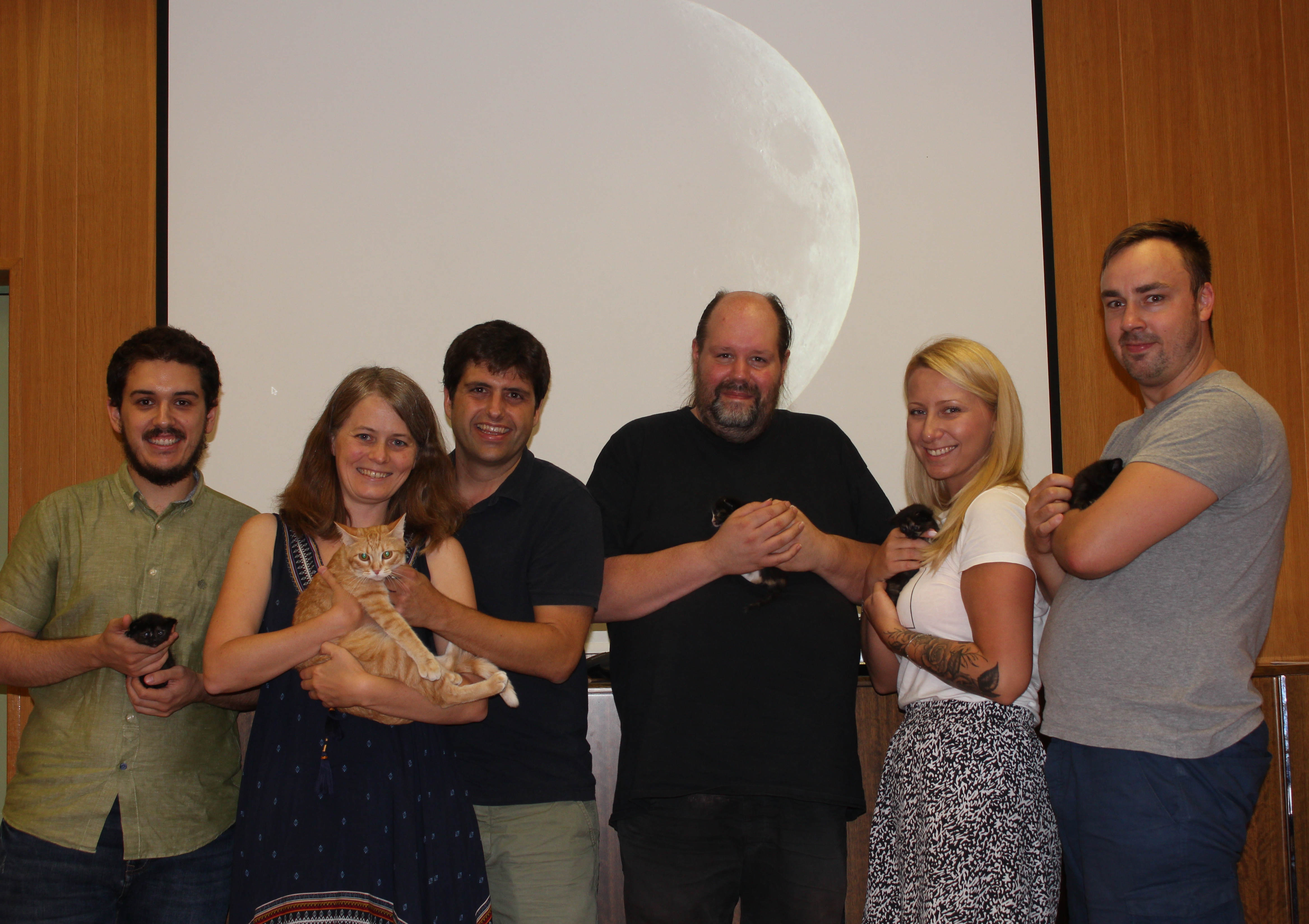
HETH in August 2019
- Christina Thöne, Ramón y Cajal fellow, group leader (cthoene at iaa.es)
- Antonio de Ugarte Postigo, Ramón y Cajal fellow, co-PI (deugarte at iaa.es) personal HP
- Alexander Kann, Postdoc (kann at iaa.es)
- Martin Blazek, PTA (alf at iaa.es) personal HP
- Kasia Bensch, PhD student (kasia at iaa.es)
- José Feliciano Agüí Fernández, PhD student (feli at iaa.es)
- Former members:
- Luca Izzo now postdoc at DARK, Copenhagen
- Rubén Sánchez-Ramírez now postdoc at INAF, Rome
- Ana Sagues Carracedo now PhD student at AlbaNova, Stockholm
- Zach Cano left astronomy
- In memoriam Javier Gorosabel (27.10.1969 - 21.4.2015)
Publications
Recent publications and highlights. A full publication list can be found in this ADS repository
Press releases
- Be-7 detection in nova Sagittarii 2015 N.2
- SN2015bh: the end of a star or an impostor?
- OCTOCAM instrument kick-off meeting
- EM counterpart of a Gravitational Wave
- Jet-cocoon signatures in a GRB-SN
- First VHE detection from a GRB for GRB 190114C and our study of its host galaxy
Publications
- GRB 190114C in the nuclear region of an interacting galaxy - A detailed host analysis using ALMA, HST and VLT. de Ugarte Postigo, A., Thöne, C. C. , Martín, S., Japelj, J., Levan, A. J. et al. (coauthors Kann, D. A., Izzo, L.) 2019, A&A, in press, arXiv:1911.07876
- GRANDMA: Global Rapid Advanced Network Devoted to the Multi-messenger Addicts. Antier, S., Agayeva, S., Ayvazian, V., Alishov, S., Arbouch, E. et al. (coauthors Blazek, M., Kann, D. A., Thöne, C. C., de Ugarte Postigo, A.) 2019, MNRAS, in press, arXiv:1910.11261
- Short GRB 160821B: a reverse shock, a refreshed shock, and a well-sampled kilonova. Lamb, G. P.; Tanvir, N. R.; Levan, A. J.; de Ugarte Postigo, A.; Kawaguchi, K. et al. (coauthors Cano, Z., Izzo, L., Kann, D. A., Thöne, C. C.) 2019, ApJ, 883, 48
- On the nature of the unusual transient AT 2018cow from HI observations of its host galaxy. Michalowski, M. J., Kamphius, P., Hjorth, J., Kann, D. A., de Ugarte Postigo, A., et al. (co-author Thöne, C. C.), 2019, A&A, 627, A10
- Highly luminous supernovae associated with gamma-ray bursts I.: GRB 111209A/SN 2011kl in the context of stripped-envelope and superluminous supernovae. Kann, D. A.; Schady, P.; Olivares E., F.; Klose, S.; Rossi, A. et al., 2019, A&A, 624, A143
- Signatures of a jet cocoon in early spectra of a supernova associated with a gamma-ray burst. Izzo, L.; de Ugarte Postigo, A.; Maeda, K.; Thöne, C. C.; Kann, D. A., et al., (other coauthors: K. Bensch) 2019, Nature, 565, 324
- The luminous host galaxy, faint supernova and rapid afterglow rebrightening of GRB 100418A de Ugarte Postigo, A.; Thoene, C. C.; Bensch, K.; van der Horst, A. J.; Kann, D. A.; Cano, Z.; Izzo, L. et al.,2018, A&A, 620, A190
- X-shooter and ALMA spectroscopy of GRB 161023A - A study of metals and molecules in the line-of-sight towards a luminous GRB de Ugarte Postigo, A.; Thöne, C. C.; Bolmer, J.; Schulze, S.; Martín, S.; Kann, D. A. et al. (other coauthors: Izzo, L.. Bensch, K.; Cano, Z.) 2018, A&A 620, A119
- The X-shooter GRB afterglow legacy sample (XS-GRB) Selsing, J., Malesani, D., Goldoni, P., Fynbo, J. P. U., Krühler, T. et al. (coauthors Cano, Z., de Ugarte Postigo, A., Kann, D. A., Thöne, C. C.), 2019, A&A, 623, A92
- The optical afterglow of the short gamma-ray burst associated with GW170817 Lyman, J. D.; Lamb, G. P.; Levan, A. J.; Mandel, I.; Tanvir, N. R. (coauthors Cano, Z., Izzo, L., Thöne, C. C., de Ugarte Postigo, A.), 2018, NatAs 2, 751
- Beryllium detection in the very fast nova ASASSN-16kt (V407 Lupi) Izzo, L.; Molaro, P.; Bonifacio, P.; Della Valle, M.; Cano, Z.; de Ugarte Postigo, A.; Prieto, J. L.; Thöne, C.; Vanzi, L.; Zapata, A.; Fernandez, D., 2018, MNRAS, 478, 1601
- The host of the Type I SLSN 2017egm: A young, sub-solar metallicity environment in a massive spiral galaxy Izzo, L.; Thöne, C. C.; García-Benito, R.; de Ugarte Postigo, A.; Cano, Z.; Kann, D. A.; Bensch, K.; Galadí-Enríquez, D.; Hedrosa, R. P.; Della Valle, M., 2018, A&A, 610, id.A11
- A spectroscopic look at the gravitationally lensed type Ia SN 2016geu at z=0.409 Cano, Z.; Selsing, J.; Hjorth, J.; de Ugarte Postigo, A.; Christensen, L.; Gall, C.; Kann, D. A., 2018, MNRAS, 473, 4257
- Cosmic evolution and metal aversion in super-luminous supernova host galaxies Schulze, S., Krühler, T., Leloudas, G. et al. (coauthors de Ugarte Postigo, A., Thöne, C.), 2018, MNRAS, 473,1258
- The MUSE view of the host galaxy of GRB 100316D Izzo, L., Thöne, C., Schulze S. et al. 2017, MNRAS 472, 4480
- ALMA and GMRT Constraints on the Off-axis Gamma-Ray Burst 170817A from the Binary Neutron Star Merger GW170817 Kim, S.; Schulze, S.; Resmi, L.; González-López, J.; Higgins, A. B. (coauthors de Ugarte Postigo, A.; Kann, D. A.; Cano, Z.; Sánchez-Ramírez, R.; Thöne, C. C.) 2017, ApJL 850, id. L21
- The Environment of the Binary Neutron Star Merger GW170817 Levan, A. J.; Lyman, J. D.; Tanvir, N. R.; Hjorth, J.; Mandel, I. (coauthors Cano, Z., Izzo, L., Thöne C. C., de Ugarte Postigo, A. 2017, ApJL, 848, id. L28
- The Emergence of a Lanthanide-rich Kilonova Following the Merger of Two Neutron Stars Tanvir, N. R.; Levan, A. J.; González-Fernández, C.; Korobkin, O.; Mandel, I. (coauthors Cano, Z., Kann, D. A., Thöne C. C., de Ugarte Postigo, A.) 2017, ApJL 848L, id. L27
- Multi-messenger Observations of a Binary Neutron Star Merger Abbott, B. P.; Abbott, R.; Abbott, T. D.; Acernese, F.; Ackley, K. (coauthors Cano, Z., Izzo, L., Kann, D. A., Thöne C. C., de Ugarte Postigo, A.) 2017, ApJL, 848, id. L12
- GRB 161219B / SN 2016jca: A low-redshift gamma-ray burst supernova powered by radioactive heating Cano, Z.; Izzo, L.; de Ugarte Postigo, A.; Thoene, C. C.; Kruehler, T. et al. (coauthors Kann, D. A.; Sánchez-Ramírez, R.) 2017, A&A 605, 107
- The Optical/NIR afterglow of GRB 111209A: Complex yet not Unprecedented Kann, D. A.; Schady, P.; Olivares E., F.; Klose, S.; Rossi, A. et al., A&A, 617, id.A122
- SN 2015bh: NGC 2770's 4th supernova or a luminous blue variable on its way to a Wolf-Rayet star? Thöne, C. C.; de Ugarte Postigo, A.; Leloudas, G., Gall, C.; Cano, Z. et al., 2017, A&A 599, A129
- GRB 110715A: the peculiar multiwavelength evolution of the first afterglow detected by ALMA Sánchez-Ramírez, R.; Hancock, P. J.; Jóhannesson, G. et al. (coauthors de Ugarte Postigo, A., Thöne, C. C., Gorosabel, J.), 2017, MNRAS, 464, Issue, 4624
- The Observer's Guide to the Gamma-Ray Burst-Supernova Connection Cano, Z., Wang, S.-Q., Dai, Z.-G., & Wu, X.-F. 2017, Advances in Astronomy, 2017, 8929054
- The superluminous transient ASASSN-15lh as a tidal disruption event from a Kerr black holeLeloudas, G., Frazer, M., Stone, N. C. et al. (coauthor de Ugarte Postigo, A), 2016, NatAs 1, id. 0002
- Highly enriched 7Be in the ejecta of Nova Sagittarii 2015 No. 2 (V5668 Sgr) and the Galactic 7Li origin Molaro, P.; Izzo, L.; Mason, E.; Bonifacio, P.; Della Valle, M. 2016, MNRAS 462, L117
- OCTOCAM: a fast multi-channel imager and spectrograph proposed for the Gemini Observatory de Ugarte Postigo, A.; Roming, P.; Thöne, C. C.; van der Horst, A. J.; Pope, S.; García Vargas, M. L.; Sánchez-Blanco, E.; Maldonado Medina, M.; Content, R.; Snik, F.; Killough, R.; Winters, G.; Persson, K.; Jeffers, S.; Riva, A.; Bianco, A.; Zanutta, A., 2016, Proceedings of the SPIE, Volume 9908, id. 990840
- A self-consistent analytical magnetar model: the luminosity of γ-ray burst supernovae is powered by radioactivity Cano, Z., Johansson A. K. G., Maeda, K., 2016, MNRAS, 457, 2761
- A young stellar environment for the superluminous supernova PTF12dam Thöne, C.C., de Ugarte Postigo, A., García-Benito, R., et al. 2015, MNRAS, 451, L6
- The host of the SN-less GRB 060505 in high resolution Thöne, C. C.; Christensen, L.; Prochaska, J. X.; Bloom, J. S.; Gorosabel, J.; Fynbo, J. P. U.; Jakobsson, P.; Fruchter, A. S., 2014, MNRAS, 441, 2034
- Spectroscopy of the short-hard GRB 130603B. The host galaxy and environment of a compact object merger de Ugarte Postigo, A., Thöne, C.~C., Rowlinson, A., et al. 2014, A&A,, 563, A62
- The unusual γ-ray burst GRB 101225A from a helium star/neutron star merger at redshift 0.33 Thöne, C. C.; de Ugarte Postigo, A.; Fryer, C. L. et al. 2011, Nature, 480, 72
Jobs at HETH
Postdoc funding
- Marie Curie individual fellowships MC-IFs are highly competitive and granted based an innovative research proposal and that should be made in strong collaboration with the hosting group. There are two modalities: incoming fellowships (2 years at a European institute) and outgoing fellowships (2 years outside Europe + 1 year at a European host). Since applications are also based on the achievements and training capabilities of the hosting group, we strongly urge interested applications to contact us early on in order to set up a competitive proposal. Deadline: (probably September 2020) Duration: 2 years Requrements: PhD defended or at least 4 years of full-time research equivalent (e.g. during a PhD). Mobility requirement: the applicant cannot have resided in the applying country for more than 12 months in the last 36 months prior to the deadline. Salaries: Net salary around 3800 EUR/month (12 payments), research funds of 800 EUR/month. Benefits: Standard Spanish employment contracts including public health insurance, pension and unemployment contributions. Some extra benefits from the MC program for familiy members. Familiy members registered in Spain furthermore also qualify for public health insurance. Link to the EU action (next call will be published in spring 2020).
- CAIXA fellowships Private foundation of the CAIXA bank for incoming researchers and researchers already in Spain with very short funding left. Fellowships are highly competitive (22 positions in all of Spain and all areas) and have to be hosted at a ``Severo Ochoa'' excellence center. IAA obtained the excellence certificate in July and hence qualifies as host for these fellowships). Deadline: (Last call closed in Oct. 2019) Duration: 3 years Requrements: PhD obtained 2 - 7 years before the deadline. Mobility requirement: the applicant cannot have resided in the applying country for more than 12 months in the last 36 months prior to the deadline. Salaries: Net salary around 3000 EUR/month (14 payments), 5400 EUR for relocation and research funds of 38,000 EUR/y. Additional funding for family members are available. Benefits: Standard Spanish employment contracts including public health insurance, pension and unemployment contributions. Some extra benefits from the MC program for familiy members. Familiy members registered in Spain furthermore also qualify for public health insurance. Link to the 2019 call.
- Juan de la Cierva fellowships Two modalities: early postdocs ("formación", 1-3 years after the PhD, PhD defended typically a few months before the deadline) and advanced postdocs ("incorporación" 3-5 years after PhD). Both fellowships are for 2 years and postdocs being granted the starting fellowship can apply for the advance one so that they follow one after the other. Current evaluations are based purly on the CV of the applicant and the merits of the group. We can support one JdC application per tutor (hence 2 in total). Deadline: (next deadline: Jan./Feb. 2020) Duration: 2 years Requirements: PhD defended between 1 and 5 years prior to the deadline (exact dates are published in each call) Salaries: 1450 EUR/month in 14 payments, reserach funds of 3000 EUR/y. Benefits: Standard Spanish employment contracts including public health insurance, pension and unemployment contributions.
- Ramon y Cajal fellowships Call published in late fall with deadline in Jan/Feb. For advanced postdocs that aim for a permanent position in Spain (note, however, that those are not guaranteed!). RyC fellows are entitled to ask for additional funding through national Spanish and regional grants. RyC fellowships are applicant based, but due possible restrictions in the number of accepted fellows within CSIC you should contact IAA before applying. Deadline: (next deadline: Jan./Feb. 2020) Duration: 5 years Requirements: PhD defended up to 9 years prior to the deadline (exact dates are published in each call), delays for childcare times apply. Salaries: 1800 EUR/month in 14 payments, reserach funds of 10k EUR/y for the first 4 years. Benefits: Standard Spanish employment contracts including public health insurance, pension and unemployment contributions.
PhD funding
- La CAIXA foundation PhD positions for "incoming" students (people who have resided <12 months within the last 3 years in Spain/Portugal) and 30 for "retaining" students (the opposite requirement). Candidates are selected in a two stage process: A preselection by an external committee and subsequent matching of the successful candidates with one of the projects offered. Deadline: Feb. 4, 2020 (incoming), Feb. 26, 2020 (retaining) Duration: 3 years Salary: ~1450€ (net) per month in 14 payments, a bonus of 7500 EUR if the thesis is handed in within 6 months after finishing the fellowship, 3564 EUR/yr for research expenses Benefits: Standard Spanish employment contract (public health insurance, contributions to pension and unemployment), extra benefits by the foundation: Mentoring program, yearly 3-5 day training session on carreer development and technology transfer, secondments to other institutions Requirements: - Not having yet obtained a PhD and being in the first 4 years of (full-time researcher equivalent) research carreers - Fulfill the mobility criteria - A completed university degree requiring 300 ECTS credits, of which at least 60 ECTS credits at the master level, or an equivalent degree from a non-European university. - B2 or equivalent in English (the call is rather restrictive about it, please read the equivalent recognizable documents in the pdf of the requirements). Program overview of the current call Link to the registered projects
- FPU fellowships Application deadline around late March. Applicants are required to be enrolled in a master program at very specific dates. Evaluations are in two stages, the first downselection is based purely on university grades after which there is another downselection on project and advisor merits. Funding is provided for 4 years on a standard employment contract including all benefits. Salaries are currently about 1000 EUR/month in 14 payments. The applicant can apply for extra funding for visits of 3-5 months at institutes outside Spain each year of the PhD.
External funding
-
We also welcome scientists that come with their own funding from abroad. If you want to stay for a few months working in one of our science areas, please contact the PIs of the group.
HETH is supported by the following funding:
- Spanish National Research Grant of Excellence under project AYA2017-89384-P "High Energy Transients and their Host: The common, the peculiar and the detailed"
- Ramón y Cajál fellowships and research funding under contracts RyC-2012-09984 and RyC-2012-09975
- AYA-JIN fellowship RTI2018-098104-J-I00
- Personal Technico de Apoyo fellowship PTA2016-13192-I

